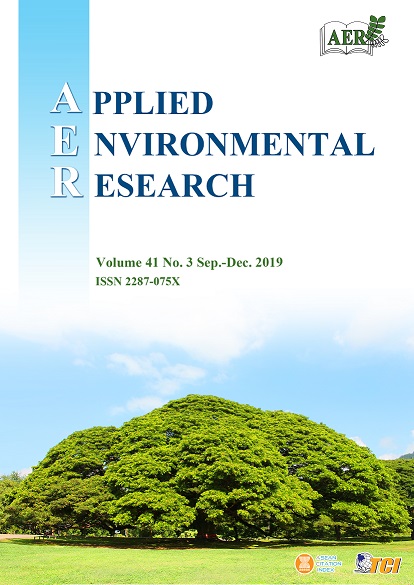Effect of Synthesized Conditions of Cu-K-OMS-2 on Toluene Oxidation Performance
Main Article Content
Abstract
The objective of this study was to optimize synthesis conditions for the Cu-K-OMS-2 hydrothermal process. The effects of ageing temperature, ageing time and amount of copper (Cu) dopant were considered via using the Box-Behnken design (BBD) method to characterize the conditions for gaseous toluene degradation. In the models studied, the independent variables were ageing temperature (55-145ºC), ageing time (6-18 h) and amount of Cu dopant (2-6% mole). The quadratic model fitted very well with the experimental data (15 runs), which showed a higher value of R2 (0.98) and adjusted R2 (0.95), confirming that the model can explain the results successfully. Ageing temperature was found to be the only significant variable for the Cu-K-OMS-2 transformation phase, with CuO and the bixbyite phase appearing as the highest ageing temperature condition. Furthermore, the effects of ageing temperature, ageing time and amount of Cu dopant on the Cu3+/Cu2+ mole ratio were also investigated. Ageing temperature and amount of Cu dopant displayed a significant effect on both toluene removal and the Cu3+/Cu2+ mole ratio. On the other hand, ageing time was not significant for both responses. The high Cu3+/Cu2+ mole ratio led to enhancement of toluene removal. The optimized conditions for Cu-K-OMS-2 synthesis were determined as 120ºC of ageing temperature, 6 h of ageing time and 6% by mole of Cu on K-OMS-2, which removed 80% of toluene at a reaction temperature of 180ºC.
Article Details

This work is licensed under a Creative Commons Attribution-NonCommercial 4.0 International License.
Published articles are under the copyright of the Applied Environmental Research effective when the article is accepted for publication thus granting Applied Environmental Research all rights for the work so that both parties may be protected from the consequences of unauthorized use. Partially or totally publication of an article elsewhere is possible only after the consent from the editors.
